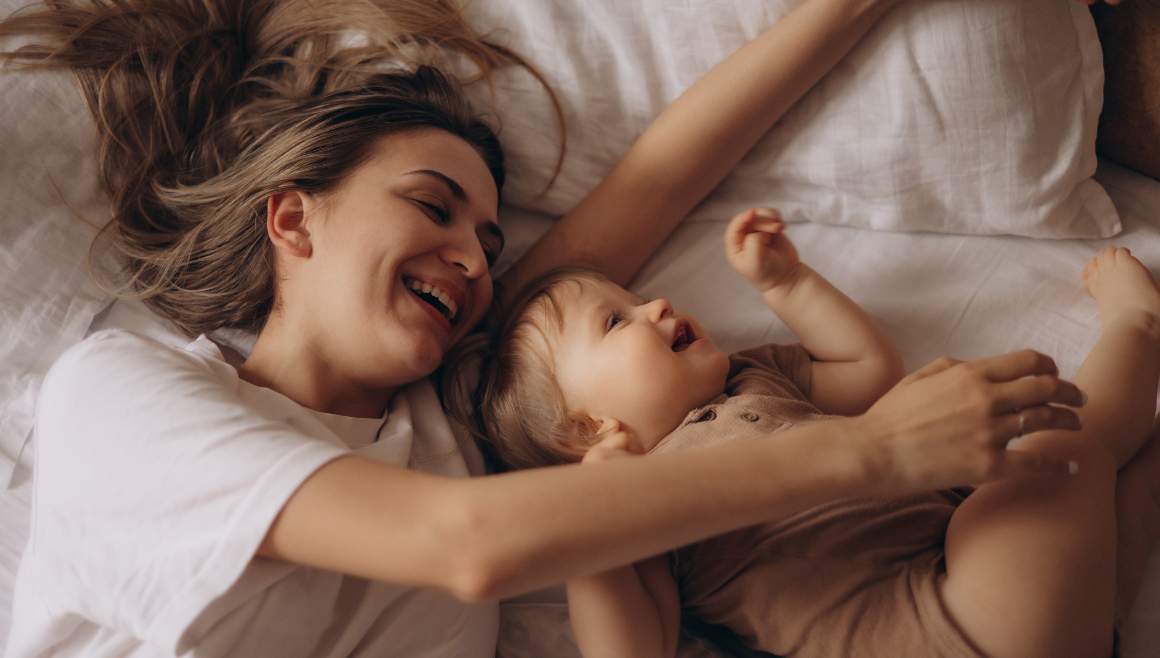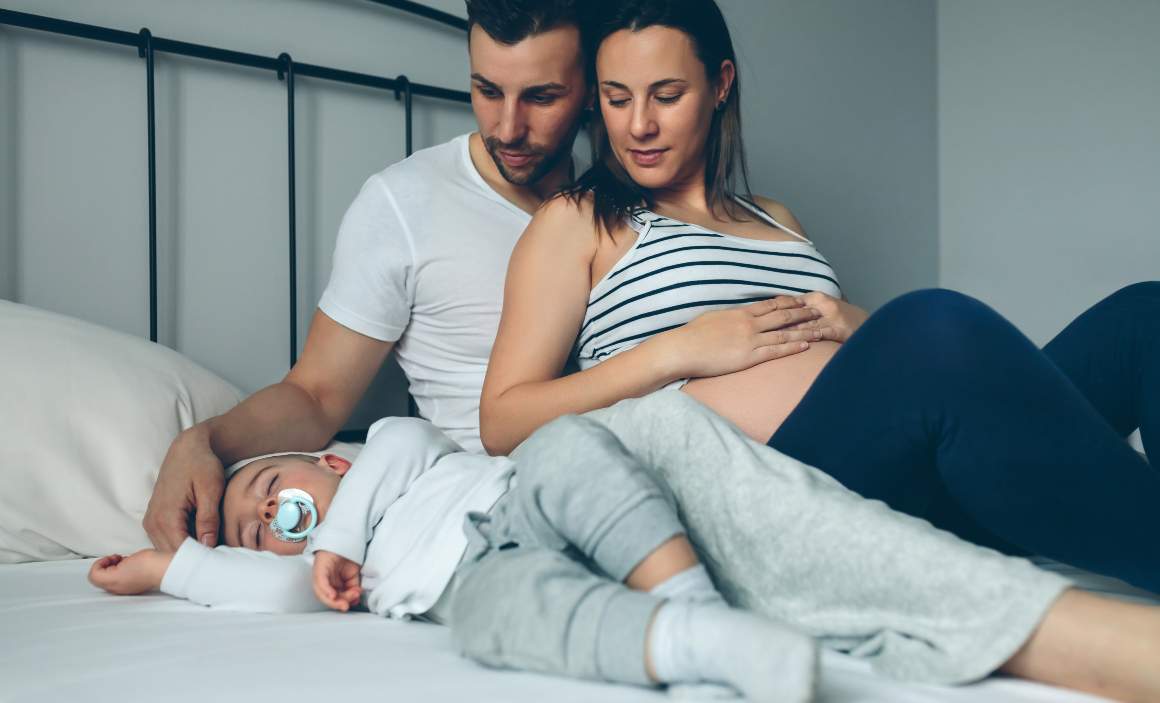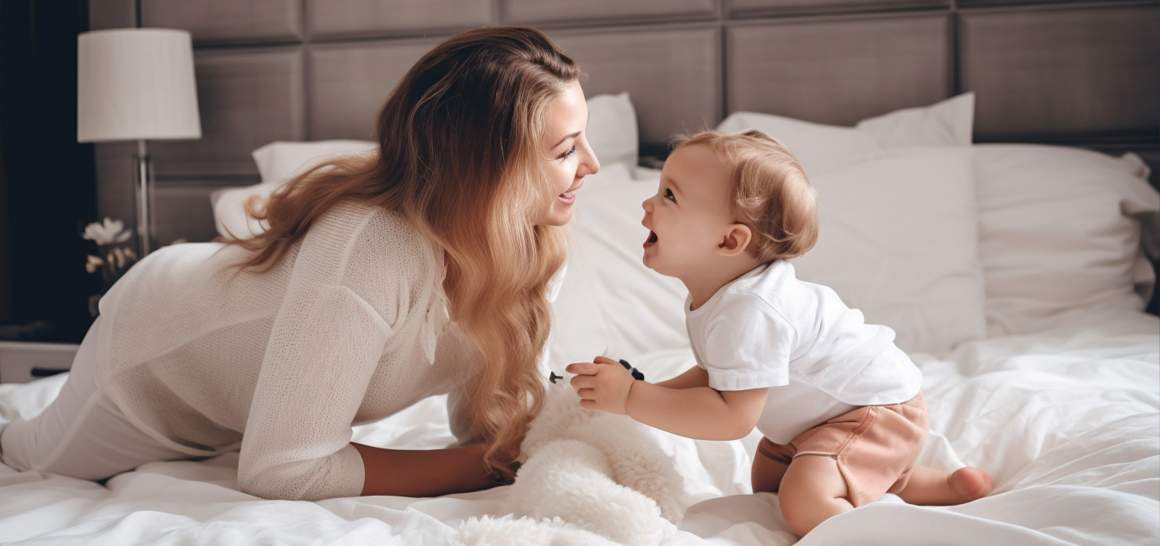Co-Sleeping
Published:
Picture this scenario: You're a new parent, and you've just brought your precious bundle of joy home. As nighttime approaches, the question of "co-sleeping" comes to mind.
Contents:
- Understanding Co-Sleeping: The Basics and Benefits
- The Dangers Associated with Co-Sleeping
- Safe Sleep Practices for Infants
- Preventative Measures Against Overlying & Unsafe Bedding Materials
- Addressing Accidental Bedsharing Among Breastfeeding Mothers
- Introducing the Term "Breastsleeping"
- Making Informed Decisions About Co-Sleeping
- Making Informed Decisions About Co-Sleeping
- FAQs in Relation to Co Sleeping
- Conclusion
Co-sleeping is an ancient practice, but one that continues to be debated and viewed differently by different people. In this blog post, we'll delve into understanding co-sleeping - its types, benefits, and potential dangers associated with it.
We will explore safe sleep practices for infants as well as preventative measures against overlying and unsafe bedding materials. For breastfeeding mothers who may accidentally bedshare during nighttime feedings, we'll discuss guidelines to follow and risks involved in such situations.
In addition to these topics, we will introduce the term "breastsleeping," which combines breastfeeding with co-sleeping while highlighting its purpose and advantages. Finally, making informed decisions about co-sleeping involves collaborating with healthcare professionals and assessing individual family needs.
So buckle up as we embark on an insightful journey through the world of co-sleeping!

Understanding Co-Sleeping: The Basics and Benefits
Let's talk about co-sleeping, also known as bed-sharing.
This sleeping arrangement involves parents sharing their sleeping area with their infant, which can have both pros and cons.
First, let's dive into the different types of co-sleeping and its potential benefits.
Definition and Types of Co-Sleeping
Co-sleeping is an umbrella term that includes various sleep practices where infants share a sleeping surface with their caregivers or other family members.
The most common form is bed-sharing, where the baby sleeps in the same bed as the parents. However, there are other forms like sidecar arrangements (attaching a crib to one side of the adult bed) or using a separate but close-by bassinet for your little one.
Benefits of Co-Sleeping
- Easier nighttime parenting: Having your baby nearby makes it simpler to attend to their needs during those late-night wake-ups. Breastfeeding mums can benefit particularly from having their baby close by, no need to rise for each feed.
- Bonding opportunities: Sharing a sleep space allows for more physical contact between parent and child throughout the night. This closeness promotes attachment while providing comfort for both parties involved in this snuggly situation.
- Potential better sleep quality: Some studies suggest that babies who co-sleep may experience fewer awakenings than solitary sleepers. Parents might also find themselves catching some extra Zzzs when they're not trekking across darkened rooms multiple times per night.
While co-sleeping can offer some benefits, it's essential to be aware of the potential risks associated with this practice.
Bed-sharing has been linked to an increased risk of SIDS and other infant mortality causes, so the American Academy of Pediatrics suggests room-sharing without bed-sharing as a safer alternative for families wanting their infants close during sleep. This is why organizations like the American Academy of Pediatrics recommend room-sharing without bed-sharing as a safer alternative for families looking to keep their infants close during sleep time.
If contemplating or already engaging in co-sleeping, be sure to become knowledgeable on secure sleep procedures and chat with medical experts regarding when and how to terminate the practice if needed. It's important to prioritize your child's safety and well-being, as well as your own.
The Dangers Associated with Co-Sleeping
Let's confront it, co-sleeping is a matter of debate.
While some parents swear by the bonding and breastfeeding benefits, others are concerned about the potential risks involved in sharing their sleeping space with an infant.
Let's explore the potential risks of co-sleeping.
Increased risk for Sudden Infant Death Syndrome (SIDS)
SIDS is every parent's worst nightmare, and unfortunately, studies have shown that bed-sharing increases this risk significantly.
recommends room-sharing without bed-sharing as a safer alternative.
Other potential hazards in a shared sleep environment
Besides SIDS, other dangers lurk when infants share their parents' bed:
- Falling asleep on soft surfaces: Adult beds often have plush mattresses or bedding materials which may pose suffocation risks for babies.
- Risk of entrapment: Infants could become trapped between the mattress and wall or furniture if they roll over during sleep.
- Pets in the bedroom: Your furry friends might accidentally harm your baby while you're all snoozing together.
- Inattentive adult sleepers: An exhausted parent might unintentionally roll over onto their baby, leading to a tragic accident known as overlying.
To ensure a secure sleeping space for your infant, it is essential to be familiar with safe sleep practices and how to discontinue co-sleeping if you are prepared to modify your nighttime parenting regimen.
Keep reading to learn about safe sleep practices and how to stop co-sleeping if you're ready for a change in your nighttime parenting routine.
Safe Sleep Practices for Infants
Let's dive into the world of infant sleep safety. To ensure your little one snoozes soundly and safely, experts recommend following certain guidelines. Here's a breakdown:
Room-sharing vs. Bed-sharing Recommendations
#1: The American Academy of Pediatrics advises room-sharing without bed-sharing. This means placing your baby on a separate sleeping surface within arm's reach but not in the same bed as you.
Proper Positioning During Sleep
#2: Always put babies to sleep on their back - this helps reduce the risk of Sudden Infant Death Syndrome (SIDS). #3: Keep pets off the sleeping area - they might accidentally harm or disturb your child while they're asleep.
Bonus Tips for Safe Co-sleeping.
- Avoid using soft bedding materials that can increase suffocation risks; opt for firm mattresses instead.
- If possible, offer a pacifier at bedtime to help soothe your baby and potentially lower SIDS risks.
Friendly Reminder About Stopping Co-sleeping
If you decide it's time to stop co-sleeping with your baby, consult with pediatricians and healthcare professionals for guidance. Consult with healthcare experts to acquire tailored tips and tricks to ensure the transition is as uncomplicated and tranquil for both you and your infant.
Ready to learn more about infant sleep safety? Check out this comprehensive guide from the Sleep Foundation.
In summary, safe sleep practices are essential in reducing risks associated with co-sleeping or bed-sharing. Educate yourself on these guidelines, consult with healthcare professionals, and always prioritize your baby's safety during bedtime routines.

Preventative Measures Against Overlying & Unsafe Bedding Materials
When it comes to co-sleeping, safety should always be the top priority.
To ensure a secure sleep environment for your little one, it's important to take steps to prevent overlying and choose the right bedding materials. Let's dive into some actionable tips.
Tips for Temperature Regulation
Maintaining an appropriate room temperature is crucial in reducing the risk of Sudden Unexpected Death in Infancy (SUDI). Aim for a comfortable range between 68°F and 72°F (20°C - 22°C). Keep in mind that overheating can be dangerous, so avoid overdressing your baby or using heavy blankets.
Choosing Safe Bedding Materials
Selecting the right bedding materials plays a significant role in ensuring your infant's safety during sleep. Firm mattresses are essential as they reduce the risk of suffocation. Avoid waterbeds, soft pillows, or fluffy comforters. Tightly fitted sheets should cover the mattress without any loose ends that could pose entanglement hazards. Breathable fabrics like cotton are ideal choices since they allow air circulation and help regulate body temperature effectively.
Baby-Box Schemes: Are They Safer?
Baby-box programs provide new parents with essential items such as clothing and safe sleeping spaces for their infants. However, research suggests that these boxes do not guarantee safer sleep conditions compared to traditional cribs or bassinets. It's essential to assess the safety of any sleeping arrangement before using it for your baby.
Addressing Accidental Bedsharing Among Breastfeeding Mothers
Breastfeeding mothers may unintentionally fall asleep while nursing at night, leading to accidental bedsharing. This can be more dangerous than intentional co-sleeping conducted safely. Therefore, understanding potential hazards and following guidelines is crucial for both mother and baby's well-being.
Risks of Accidental Bedsharing & Guidelines
The Royal College of Midwives (RCM) provides guidelines on safe bedsharing practices among breastfeeding mothers. Create a safe sleeping environment by removing pillows, duvets, or other soft objects from the bed. Avoid consuming alcohol or drugs as they can impair your ability to respond quickly in case of an emergency during sleep.
In conclusion, taking preventative measures against overlying and unsafe bedding materials is vital when considering co-sleeping arrangements. Always prioritize your infant's safety above all else. If you're experiencing sleep problems with your child, consider seeking advice from a healthcare professional. Solitary sleepers can also benefit from a safe and comfortable sleeping area. Remember, there are many ways to practice nighttime parenting that don't involve bed sharing or placing infants in adult beds. Stop co-sleeping if it's causing family stress or if you're not comfortable with it. Infants sleeping in their parents' bed can increase the risk of infant death, especially for cosleeping mothers. Let's prioritize safe sleeping practices for our little ones.
Addressing Accidental Bedsharing Among Breastfeeding Mothers
Let's face the reality that, as a sleep-deprived parent, mistakes can occur when managing breastfeeding and nighttime parenting. Especially when you're a sleep-deprived parent trying to navigate the world of breastfeeding and nighttime parenting. So, let's talk about accidental bedsharing and how we can minimize risks for both mom and baby.
Risks of Accidental Bedsharing
The truth is, accidental bedsharing can be more dangerous than intentional co-sleeping conducted safely. This is because parents may not have taken necessary precautions or set up their sleeping area with safety in mind if they didn't plan on sharing their bed with their little one.
Guidelines for Breastfeeding Mothers
#1: First things first - make sure your sleeping surface is safe. A firm mattress without gaps between the headboard or wall where your baby could become trapped, no heavy blankets, pillows, or stuffed animals that could pose suffocation hazards, and avoid waterbeds, couches, or recliners as these surfaces are not suitable for infant sleep.
#2: Be mindful of any medications that might cause drowsiness during breastfeeding sessions at night - this increases the risk of accidentally falling asleep while nursing.
#3: Set up a safe room-sharing arrangement, with your baby in a separate sleep space like a bassinet or crib near your bed. In the event of dozing off while nursing, setting up a separate sleep space close to your bed can make it easier to transfer them back after waking.
#4: If you're concerned about falling asleep during nighttime feedings, try sitting up in bed or using an armchair for breastfeeding sessions instead of lying down. This can help keep both mom and baby more alert during feeding times and reduce the risk of accidental bedsharing.
Making Nighttime Parenting Safer
The bottom line is that understanding potential hazards involved in co-sleeping and accidental bedsharing is crucial for ensuring the safety of our little ones at night. Speak with your doctor or medical practitioner regarding any worries related to nursing and sleeping arrangements - they can give individualized advice specifically for the requirements of your family.
Source: https://www.ncbi.nlm.nih.gov/pmc/articles/PMC2693166/
Introducing the Term "Breastsleeping"
Let's talk about a new term that has emerged in the world of co-sleeping.
"Breastsleeping" is an innovative concept that aims to remove negative connotations associated with traditional co-sleeping practices.
This term was introduced by an integrated analysis conducted by sleep and lactation experts. You can read more about it here.
Definition and Purpose of Breastsleeping
Breastsleeping refers to safe bed-sharing practices specifically for breastfeeding mothers and their infants.
The purpose behind this terminology is to encourage data-driven discussions on best practices related to both breastfeeding and infant sleep arrangements.
Benefits of Using This Terminology
- Educational: The term breastsleeping emphasizes the importance of understanding safe sleeping arrangements while promoting successful breastfeeding relationships between mother and baby.
- Actionable: By introducing this new terminology, healthcare professionals can provide clear guidelines on how parents can safely engage in breastsleeping without increasing risks associated with SIDS or other hazards.
- Inclusive: Recognizing that many families choose co-sleeping as part of their nighttime parenting routine, using the term breastsleeping acknowledges these choices while still advocating for safety precautions.

Making Informed Decisions About Co-Sleeping
To ensure the best possible environment for your infant, it is imperative to collaborate with healthcare professionals and make informed decisions about co-sleeping.
Working in conjunction with medical experts is essential for ascertaining the potential hazards of co-sleeping, and how to lessen them if this sleeping arrangement is chosen.
Collaborating with Healthcare Professionals
Consulting with experts will help you understand the risks associated with co-sleeping, as well as how to mitigate those risks if you choose this sleeping arrangement.
Your pediatrician may recommend room-sharing without bed-sharing as the safest option for reducing SIDS risk while still promoting bonding and breastfeeding success.
Assessing Individual Family Needs
It's essential to take into account the particular family's culture, inclinations, and situations when selecting a sleeping setup that is ideal for all.
If you opt for co-sleeping or breastsleeping, make sure you're educated about necessary precautions like proper positioning during sleep, temperature regulation tips, choosing safe bedding materials, and more - all crucial aspects of ensuring a secure environment for your little one.
Making Informed Decisions About Co-Sleeping
As parents, it's essential to make informed decisions about your baby's sleeping arrangements. Working closely with healthcare professionals and pediatricians can help you understand the safest practices specific to your little one's needs.
Room-sharing without bed-sharing is recommended as the best option for reducing risks associated with co-sleeping. However, if you choose to co-sleep or breastsleep, being educated on necessary precautions is crucial for a safe sleeping environment.
Collaborating with Healthcare Professionals
Your pediatrician should be consulted for advice on co-sleeping, to ensure any potential risks are identified and addressed accordingly. Their guidance will ensure that you're aware of any potential hazards and how to mitigate them effectively in your unique situation.
Assessing Individual Family Needs
- Solitary Sleepers: Some infants may prefer their own space, so consider providing a separate sleeping area like a crib or bassinet within arm's reach of the caregiver's bed. This setup promotes bonding while still adhering to safe sleep guidelines.
- Breastfeeding Mothers: If nighttime nursing sessions are frequent, accidental bed-sharing becomes more likely. Be prepared by learning proper positioning techniques during breastfeeding and creating a safer shared sleeping surface if needed.
- Family Stress: If co-sleeping causes tension or disrupts sleep for any family member, it's essential to address these issues and find alternative solutions that work best for everyone involved.
Making informed decisions about your baby's sleeping arrangements is a critical aspect of nighttime parenting. Gaining knowledge of the pros and cons related to co-sleeping, consulting medical professionals, and evaluating your family's specific requirements are all essential for providing a secure and restful night for both you and your baby.
FAQs in Relation to Co Sleeping
What Does Research Say About Co-Sleeping?
Research on co-sleeping presents mixed findings. Some studies suggest that it can promote bonding, facilitate breastfeeding, and improve infant sleep patterns. However, other research indicates an increased risk of Sudden Infant Death Syndrome (SIDS) and other hazards in a shared sleep environment. It is essential for parents to weigh the benefits and risks before deciding on co-sleeping practices. (source)
At What Age Is Co-Sleeping Inappropriate?
There isn't a specific age when co-sleeping becomes inappropriate; however, the American Academy of Pediatrics recommends room-sharing without bed-sharing until at least 6 months but preferably up to one year of age to reduce the risk of SIDS. (source)
Is It Biologically Normal to Co-Sleep?
Biological evidence suggests that humans have evolved as a cooperative breeding species, with infants sleeping close to their caregivers for warmth, protection, and easy access to breastfeeding. While modern societies may have different sleeping arrangements due to cultural factors or safety concerns, (source) some argue that co-sleeping remains a natural human behavior.
What Issues Are Caused by Co-Sleeping?
- Increase in Sudden Infant Death Syndrome (SIDS) risk (source)
- Potential hazards in shared sleep environments, such as suffocation or entrapment (source)
- Disruptions to parents' sleep quality
- Possible difficulties transitioning the child to their own bed later on
Conclusion
Co-sleeping may be contentious, yet it is essential to understand the potential advantages and dangers connected with this custom. While co-sleeping may improve parent-infant bonding, it also increases the risk of SIDS and 'overlying.' Safe sleep practices such as room-sharing without bed-sharing and proper positioning during sleep can help mitigate these risks.
Breastfeeding mothers should take extra precautions when considering bedsharing, including unintentional vs intentional bedsharing and following safety guidelines. It's also important to make informed decisions about co-sleeping by collaborating with healthcare professionals and weighing the risks & benefits before making a decision.













